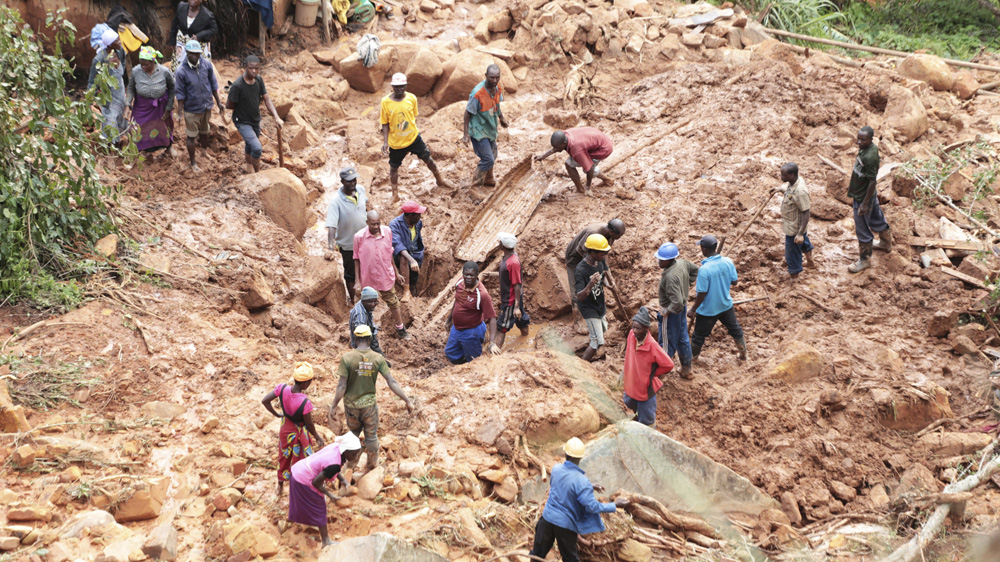UN calls for aid as displaced from Cyclone Idai may reach 2m
Geneva, Switzerland – At least half a million Mozambicans have been displaced by cyclone Idai, but that figure may rise to four times that in the aftermath of the devastation, United Nations officials warned on Tuesday.
The World Food Programme (WFP), UNICEF, and other UN agencies launched an appeal for immediate international funding and logistical support to save hundreds of thousands who remain isolated and with no access to food or clean water in Mozambique, Zimbabwe and Malawi.
In Mozambique, the government’s estimates put the number of those affected by the cyclone at 600,000 in the provinces of Sofala, Manica, Zambézia, Inhambane and Tete.
A WFP staff member, who flew over the area inundated since the weekend when two swollen rivers burst their banks, spoke of “inland oceans extending for miles and miles in all directions”.
 |
| A Zimbabwean family dig for their son who got buried in the mud when Cyclone Idai struck [Tsvangirayi Mukwazhi/AP] |
The situation is particularly dire in the port city of Beira, where thousands are still on rooftops and in trees waiting to be rescued, as the flood reached a height of six metres, UN officials said.
“A lot is needed, the world doesn’t realise the scale of the problem especially in Mozambique, where some 1.7 million people were on the path of the cyclone,” said Herve Verhoosel, WFP spokesperson.
Some 920,000 people were affected in Malawi with some 82,000 being displaced, but UN officials said the impact was limited and people were returning to their homes on Tuesday, as further assessments were under way.
|
Cyclone Idai death toll at 215, Beira city ’90 percent destroyed’ |
In Zimbabwe, some 15,000 people have been displaced, with Chimanimani and Chipinge being the hardest-hit districts.
“People visible from the air may be the lucky ones, and the top priority now is to rescue as many as possible and ferry them to safety,” said Lola Castro, WFP Regional Director for Southern Africa.
Addressing reporters in Geneva, Castro said assessing the extent of the damage and needs is a huge challenge given the poor weather conditions, the limited access to the areas hit by the cyclone and the complete power and telecommunications blackouts.
Castro said the UN has suggested that the Government of Mozambique ask South Africa to help create an air bridge in order to reach the most isolated areas, where people have lost everything. UNICEF launched an appeal on Tuesday for $20.3m to support the response in the three countries.
Airlifts started
The WFP said an MI-8 transport helicopter had started airlifts on Tuesday, with two more aircraft scheduled to arrive before the end of the week. On Tuesday WFP airlifts dropped high-energy biscuits, water and blankets to people crammed on rooftops and elevated patches of land outside Beira.
Negotiations by the WFP to bring to Beira two freight aircraft, including a Hercules C-130, are at an advanced stage, Verhoosel said.
While the agency’s warehouse in Beira was badly damaged by the cyclone, some food remained intact. From that stock, WFP staff who were in the city prior to the cyclone, continued to provide easy-to-prepare fortified food to thousands displaced who found shelter in 18 schools and churches in the area.
Heavy rains to continue
Heavy rainfall is projected to continue in Sofala and Manica provinces from 19 to 21 March. With heavy rain continuing and forecast to persist for days, concern is growing about further flooding as rising water makes its way down Mozambique’s main river systems.
Alerts have been issued regarding the risk of flooding in the Buzi, Pungoe and Save river basins in the next 72 hours, which could lead to further destruction and potential loss of life. The Buzi river has already burst its banks killing hundreds.




